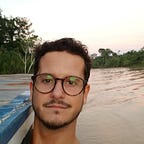A reflections on my personal process, and a safe destination.
If you find yourself touched by the big problems of the world, reading news and articles, following activists, watching documentaries about sustainability, sharing your pragmatism with polarized friends and thinking that the problems of your job is mediocre… Honestly, you are just feeling the symptom of a generation.
You are not alone, there are a lot of people out there with the same feelings. Myself included. What I tried to do was to organize this emotions to become something more part of who I am. Merging personal and professional life. Become one.
And share on this post to influence more people to do it.
#1 The Problem: find a problem you are passionate about.
Best way to start is to read the 17 UN Sustainable Development Goals and its targets, choose the ones you would like to solve. I picked #13 (Climate Action), #14 (Life Below Water) and #15 (Life On Land). Best part of doing this is the relief of not feeling guilty about the other goals.
With my goals in mind, I started to do a deeper study:
- Reading books. My favorites are The Ecology of Commerce, Cradle-to-cradle and Sustainable Excellence.
- Doing courses. I used Coursera. My favorite course was Ecosystem Services. I also recommend to pay for the certificates before you start, so you have the commitment to finish it.
- Events and networking. It’s hard to finish a full day job and go to an event that you look like an outsider, but that’s how I did it. I used Eventbrite and researched about topics related with my goals, then I registered and added to my calendar.
- Subscribe to newsletters: e-mail is still the channel that I always look at. I recommend Sustainable Brands, SustainAbility, Ellen McArthur Foundation and Sustainable Alpha.
- Talk with People: I talked with my inner circle of friends. Positioning myself, so it could trigger my commitment (like stop smoking), and to connect with more people.
#2 The Solution: find something worth spending time with.
I researched about “The Problem” for probably 3 years while working at a full-time job. At some point, things started to repeat and I was becoming more comfortable talking about it.
So I moved to a more higher level. I’ve tried to be more open to serendipity. I was looking deeper into things that popped-up more often from credible sources, or things that were making obviously-weird connections. On the top of that, looking into something that would be useful in 10 years from now.
I’m not here to influence you on my journey, but Agroforestry was my thing because it has the legacy of agriculture with the modern approach of design thinking and systems. For me, Agroforestry is the coding of life with a magical variable called nature. So I was happy to spend time with:
- People that influenced the field: Ernst Gotsch, Ana Primavesi and Masanobu Fukuoka.
- Similar disciplines: Permaculture, Biodinamic, AgroEcology.
#3 The You: find something that’s inside of you.
You can’t fake this process, you need to own it. And my ownership get stronger with unquestionable facts. I’m Brazilian and the Amazon (the biome, not the company) always got me more emotional, especially while living outside Brazil. People see you as the person that live in the lungs of the world, and you got to own it. Additionally, my dad in his early career use to work at FUNAI (Brazilian Indigenous Foundation), we travelled to the Amazon together, and he’s always taught me lessons about it.
Other concrete fact is that I had over 12 years in the creative industry building brands. That is an amazing asset in the AgriBusiness industry. However, there is a limit. It’s really difficult to brand and marketing a commodity, which its demand is based on price. So, I had to find an opportunity.
#4 The Opportunity: find a gap.
The Fashion Industry is so late on sustainable processes, from social to environmental capabilities. Today, 90% of the market consist of non-responsible fibers, they are either synthetic fibers (polyester, nylon and acrylic) or cotton from conventional farming (which is the crop that use most chemicals). On the other side, brands, pressured by markets, are making commitments to change the industry in the next 15 years and to have 100% of responsible materials. Change is a certainty.
Additionally, the fashion supply chain is long, old and too big to move fast. Everybody looks at the design, upcycle and aesthetics, few look at the dirty and cluttered back-end of it. I started to look at the dirty bit, and raw materials became my business opportunity.
Let’s stop for a second
Things weren’t smoothly as written here. The process is chaotic. While thinking on how to represent it, the only thing that came to my mind was:
Connecting the dots.
If you never watched Steve Jobs speech. I think you should (even though is not about sustainability). My process was an always-on, back and forth, testing and learning until I found a solution that we call Textile Agroforestry, my company, FARFARM, plants natural fibers using Agroforestry systems and creates fabrics that regenerate nature.
We are one year formally operating, already incubated by Amazonian Entrepreneurship Center (AmazôniaUP) and by Fashion For Good, based in Amsterdam. I left work and business is open with a small revenue stream, but running, and I have indeed merged personal and professional life.
“Follow your passion” leads to certain amount of pressure and heaviness. It’s “seeds of curiosity” that can lead to flowers of passion — Elizabeth Gilbert.
Nobody is in favor of un-sustainability.
I have no doubt that sustainability will become so important to actually disappears, and be embedded on everything we do. I hope this process gives you seeds of curiosity, that will become flowers. And we all pivot businesses until it doesn’t have to be called sustainable anymore.
